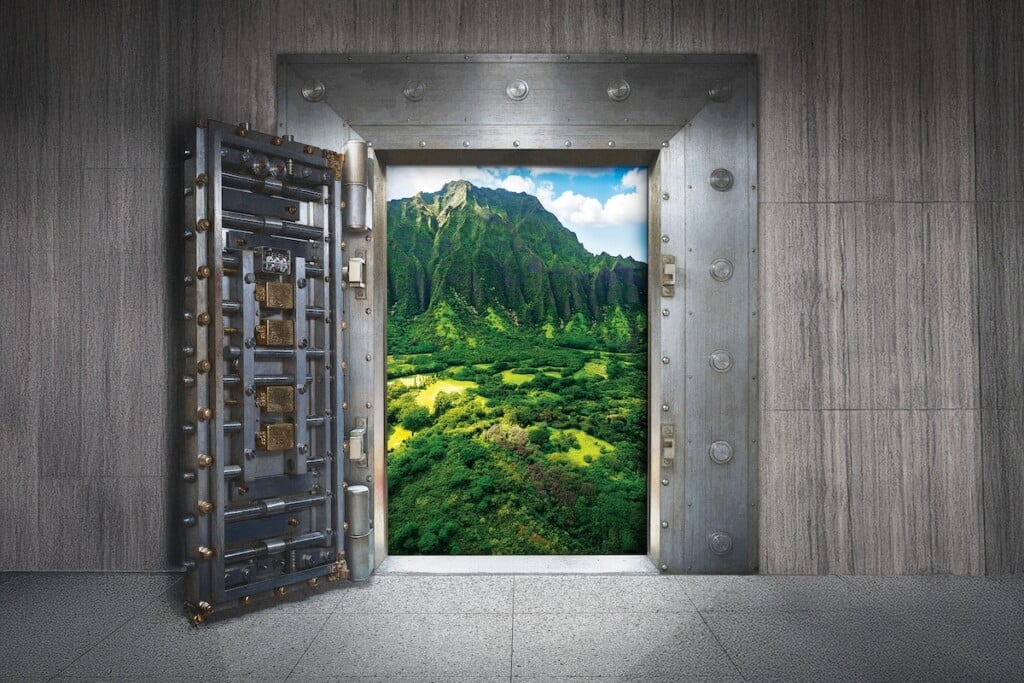Hawaiʻi Primed to Revive Agriculture
Conditions may finally be ripe for a rebound in diversified agriculture

Making agriculture a viable industry in today’s Hawai‘i is a daunting task. Biosecurity, agricultural crimes, infrastructure, land availability, an aging workforce, limited markets and few food processing centers are among the barriers facing this comparatively small segment of the state’s economy.
But the state is planning and building a new network of opportunities and support intended to reinvigorate Hawai‘i’s agricultural sector.
“It was generally thought that when sugar and pineapple plantations shut down, former plantation crop land would be cultivated with numerous smaller crops,” wrote UH economists Sumner La Croix and James Mak in 2021. “Instead, much of it lies fallow.”
So true, but after decades of decline and stagnation, conditions may be ripe for a rebound in diversified agriculture.
The department’s back
The state Department of Agriculture was renamed the Department of Agriculture and Biosecurity on June 27, marking a new era for the agency, with new responsibilities and increased collaboration with other state agencies. Director Sharon Hurd says the legislation that passed this year prioritized biosecurity and the deterrence of agricultural crimes, like theft of crops, livestock and equipment, and increased access to capital for agricultural entrepreneurs.
The department’s kuleana is massive. “All those readers at the supermarket, we check those. We check gas [pump] meters. We check taxicabs. We check scales at the farmers markets. Any measuring device is under our purview, in addition to biosecurity, land and water for agriculture, loans, marketing.”
Last year, Gov. Josh Green signed Act 231 to create 44 positions for entomologists, plant quarantine inspectors, environmental health specialists and others. It was one of the most significant expansions of the department in 30 years.
The increase was driven by increased public awareness of invasive species statewide. “Biosecurity was less important when it was only impacting agriculture,” explains state Rep. Kirstin Kahaloa, former chair of the House Agriculture & Food Systems Committee. “As soon as it started impacting families in their yards, when it impacted schoolkids on their playgrounds, and now the beautiful landscape of our coconut trees across our street, now it has elevated to the level that we’ve needed for many decades.”
Ironically, these positions existed over a decade ago, but the 2009 Legislature reduced the Department of Agriculture’s budget by 19% and devastated institutional memory and expertise. As a result of the reduction in force order, 96 of the department’s 214 general-funded positions were eliminated.
Following the 2009 layoffs, the Hawaii Invasive Species Council, Ulupono Initiative, UH’s Coconut Rhinoceros Beetle Response team and Ant Lab, and other organizations, struggled to fill the void.
But the crippling of the department’s biosecurity functions continues to reverberate. “We’re still coming back from that,” laments Hurd. “These 44 positions that the Legislature was so kind to give us last year just bring us back to where we were in 2009. Now we have a chance to build from there.”
Among the species the department needs to target are the coconut rhinoceros beetle, coqui frog, little fire ant, rose-ringed parakeet and two-lined spittlebug.
But, Hurd declares: “The department’s back. We’re back to where we were.”
A two-legged stool
“There is an old saying that beginnings are delicate times, and with the pace of our modern world, that statement is even more valid,” wrote Bart Jones in 1994, when he was a member of the Honoka‘a Farmers Cooperative of East Hawai‘i Island. That was when the Hāmākua Sugar Plantation went bankrupt and closed, part of the overall decline of sugarcane in Hawai‘i.
Jones knew establishing a new agricultural regime would prove harrowing. “It is very easy to kill a seed, and it is easy to destroy a seedling, and it is very difficult to establish and maintain all the elements that are necessary to develop a new crop,” he wrote at the time.
1994 was also the year the state Legislature declared: “Within the next decade, 75,000 acres of agricultural lands and 50 million gallons per day of irrigation water are expected to be released by plantations. The downsizing of the sugar and pineapple industries will idle a valuable inventory of supporting infrastructure including irrigation systems, roads, drainage systems, processing facilities, workshops and warehouses.”
Transferring fallow agricultural lands and their infrastructure to new uses was the primary mission of the Agribusiness Development Corp., which was established that year.
However, multiple reports have criticized the ADC, including research reports issued by the Legislative Reference Bureau in 1997 and 2007 and a scathing performance audit in February 2021. “More than 25 years after its creation, we found an agency that is generally unaware of its unique powers and exemptions, and has done little – if anything – toward achieving its statutory purpose,” the state auditor reported in 2021.
When longtime ADC Executive Director James Nakatani died in April 2023, the beleaguered agency was at a critical juncture. Four months later, Wendy Gady got the job.
Gady exudes a dogged, collaborative and transparent attitude. Since September 2023, she has publicly released weekly reports, which function as briefings on the ADC’s work. (Find them at dbedt.hawaii.gov/adc/reports.)
Furthermore, the ADC has made efforts to address historic sources of criticism. In November 2024, the state auditor’s office found the ADC had fully implemented 30 of the 36 recommendations in its 2021 audit. The other six were no longer applicable.
Gady says the agency’s agenda is to find partners who align with its mission of building a new statewide food system: “We’re looking for radical collaborators. We’re looking for talent. We’re looking for farmers. We’re looking for food entrepreneurs.”
To much of the general public, the Agribusiness Development Corp. – part of DBEDT – appears at first glance to duplicate the role of the Department of Agriculture, but Gady explains the difference. “They are regulatory, so they handle everything from plant quarantine to invasive species.”
The Department of Agriculture also works with small, beginner farmers. Its “agricultural parks are designed for people that are just starting out.”
Once a farmer is more firmly established, the next step is the ADC, Gady says. “When you’re ready to graduate, you’re graduating to ADC. And that creates new room in the agricultural park for a new entrepreneur to come in and hopefully get birthed into the ADC.”
To use a business term, much of ADC’s mission today is to bring fledgling agricultural businesses to scale. Providing long-term licenses to operate on ADC lands – up to 35 years – provides stability for farmers who may be working on month-to-month leases under private landlords.
And stability for farmers means stable food systems for consumers and a foundation for Hawai‘i’s food security. “We have to make things work here. We can’t count on the white horse to come in on a ship,” Gady says.
Much of ADC’s current focus is the maintenance of irrigation infrastructure on Kaua‘i and O‘ahu – infrastructure that creates the capacity for irrigated agriculture. The Kekaha ditch system supplies the East Kaua‘i Irrigation System and the Waiāhole water system on O‘ahu feeds the Wahiawa Irrigation System.
“The future of agriculture consists of infrastructure facilities around application and irrigation,” explains Dane Wicker, deputy director of the Department of Business, Economic Development & Tourism, which includes the ADC.
“All of those are high-cost [investments] that no farmer alone – or collectively – can support financially. If the state is going to be serious about food security and resiliency, then the state needs to make investments in land acquisition,” and then plan, design and build those key facilities, Wicker says. “That’s the future of agriculture.”
The vast majority of ADC’s portfolio is focused on O‘ahu and Kaua‘i. Kaua‘i alone accounts for about 80% of the ADC’s inventory of land, though there is interest in expanding capacity on Hawai‘i Island and Maui. It’s a matter of time, money and available parcels suitable for cultivation, acknowledged Wicker and Gady.
The state’s budget for the fiscal year 2026 sets aside $39 million to buy 1,000 more acres on Kaua‘i. There are also plans to spend $17 million to build a small animal processing and storage facility on O‘ahu, which would lead to more Hawai‘i-raised meats for consumers.
Two relatively new facilities help turn ag produce into sauces, snacks, jams, cookies and more: The Wahiawā Value-Added Product Development Center, opened in April 2024 on O‘ahu, and the Maui Food Innovation Center, opened in November 2022 in Kahului.
The Local Food Coalition, an alliance that includes the Land Use Research Foundation of Hawaii, UH’s College of Tropical Agriculture and Human Resilience, the Ulupono Initiative, Hawai‘i Farmers Union United and the Hawaii Food Industry Association, emerged as a key proponent for this network. “Value-added manufacturing plays an indispensable role in bolstering both our agricultural sector and the broader economy,” testified the coalition to the Legislature on April 1. “Establishing a network of open-access food and value-added product development facilities is not merely an aspiration but a necessity in our quest for agricultural and economic sustainability.”
Among the coalition’s goals is to add incubators on other islands, like those in Wahiawā and Kahului.
“These spaces are where small businesses can safely and affordably produce value-added products, like jams, jellies, sauces, pickles, dry goods – anything coming from local agriculture and something that can now have shelf life,” says Kahaloa, who represents the Kona district of Hawai‘i Island. “There’s been a lack of access to certified kitchens. It’s very expensive for agriculture to be able to create their own facility for one value-added commodity. What this does is really break barriers, especially in our rural communities and former plantation communities across Hawai‘i.”
The state is trying to increase demand and generate a market for local ag products, beginning with vendors across government departments. A 2019 law committed Hawai‘i to doubling food production by 2030. In 2021, a farm-to-school program was established within the Department of Education; it mandated that 30% of all food served in public schools consist of “locally sourced products” by 2030. Another law set goals for every “principal department” in state government to procure a certain level of locally sourced products when it contracts for services.
The future of local agriculture appears heavily contingent on sustained government investment. As Gady explains, “ADC was created to step in as sugar and pineapple stepped out. We were a three-legged economic stool [in the past]: We had ag with sugar and pineapple, we had tourism, we had the military. When you take sugar and pineapple out, your stool is really unbalanced. You only have two legs.”
Restoring the stool’s third leg would still require agricultural interests to navigate competing demands for agricultural lands, including solar projects.
Most Ag Lands Are Pastures
The Hawai‘i State Data Book estimates that 1.93 million acres of land is zoned for agricultural purposes. That’s a lot – almost half of the land in Hawai‘i. The landmass of all the Hawaiian Islands together, except for Hawai‘i Island, totals only 1.54 million acres.
The 2020 Update to the Hawai‘i Statewide Agricultural Land Use Baseline found that only 886,211 acres of land – less than half of all agriculturally zoned lands – presently are used for agriculture.
Most of that land is set aside for pastures. Only 120,632 acres – less than 7% of all agriculturally zoned lands in Hawai‘i – were under crop cultivation, according to the land use update. With so much agricultural land unsuitable for cultivation due to soil quality, lack of water, isolation and unsuitable terrain, there is a natural question: How do we effectively use all of Hawai‘i’s agricultural lands?
While agencies like the Agribusiness Development Corp. are working to bring more agricultural land into cultivation, solar energy facilities have been permitted on agricultural lands that meet certain classifications.
That pits agricultural projects against solar projects and clean energy goals. House Bill 778, passed this year by the Legislature and signed into law by the governor, calls for an integrated land use study to inventory all of the grand goals set by the Legislature through the years.
The new law states that “multiple climate and sustainability statutory targets have been enacted in the State, including developing at least 22,500 affordable rental housing units, doubling food production, increasing food exports, requiring the Department of Education and University of Hawai‘i to become net-zero in energy use, requiring that all of the electricity generated in Hawai‘i comes from renewable sources, sequestering more atmospheric carbon and greenhouse gases, requiring all state and county facilities to use reclaimed water, and requiring the mandatory upgrade of all cesspools.”
It is a daunting list of targets. For the next two years, the law requires the state’s sustainability coordinator, Danielle Bass, to facilitate conversations and collect “data-based estimates on the amount of land required” to meet the needs of these competing uses within agricultural districts. To do so, the Office of Planning and Sustainable Development must compile and analyze existing data while working with farming groups, counties, community members and state government entities.
The goal is to “clearly define and prioritize the protection of productive agricultural lands to prevent further encroachment from nonagricultural developments, including developing measures to ensure agricultural lands designated for agriculture production are not compromised for short-term development needs.”
Balancing the state’s multiplying mandates is a crucial overdue conversation for state planners. “We have our urban growth boundaries. We have our general plans. We have our sustainable community plans,” explains Bass. “But what are we doing? We’re still being reactive instead of being proactive in terms of land use.”
The Office of Planning and Sustainable Development’s study could set the trajectory of any agricultural resurgence, says Wicker, the DBEDT deputy director. “Until we know what lands are critical for food production, we cannot piecemeal and say ‘OK, solar farm you go there,’ or ‘Biofuel, you go there,’ because [these uses] may not be able to coexist with the land we’ve identified for crop production.”
Coordinating competing uses is the goal, Bass says. “When I see these three big buckets of housing, energy, agriculture, it’s less about the competing uses of the same land.” Instead, coordination among stakeholders is key. There could be enough land to balance these competing needs and even rezone certain agricultural lands for conservation, but such work would have to be coordinated.
The Challenges Ahead
Perry Philipp, a UH College of Tropical Agriculture professor, wrote in 1953: “It is evident that many of Hawaii’s diversified agricultural industries show promise for expansion and that such expansion would materially strengthen Hawaii’s economy. To bring it about [Hawai‘i needs people with] vision, enterprise, venture capital and capacity for hard work.”
As Governor Green signed several pieces of agricultural legislation into law on June 27, Philipp’s attitude returned to my mind.
“Farming and ranching are a tough business,” Brian Miyamoto, executive director of the Hawai‘i Farm Bureau, said at the event. “Land use, water, labor, energy, supply chain disruptions, natural disasters: These are issues that our farmers deal with every single day.”
True in 1953, true today and true, undoubtedly, into the future.






